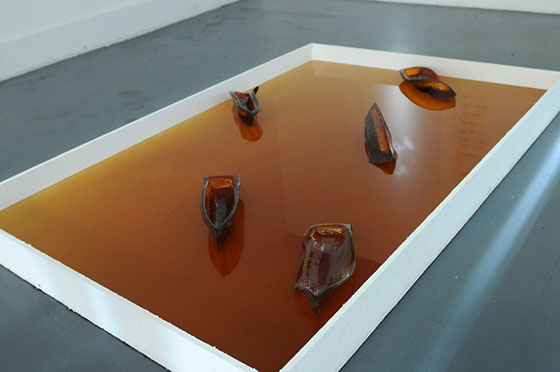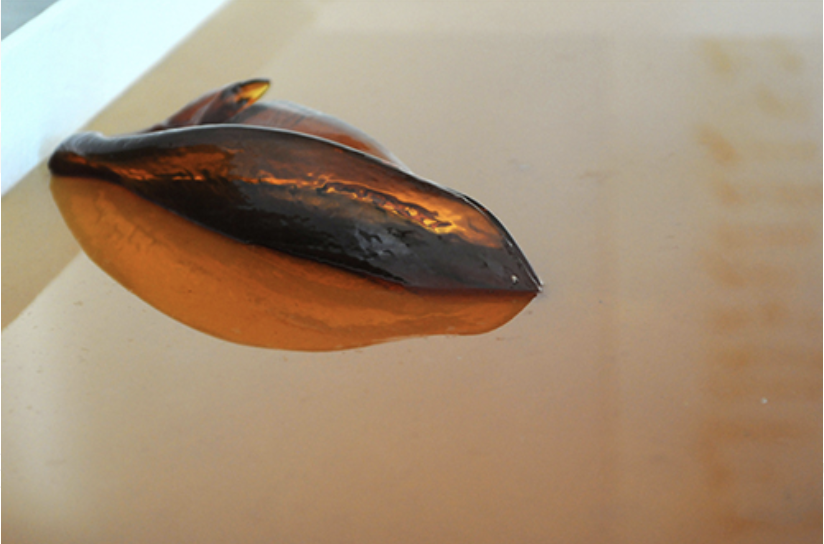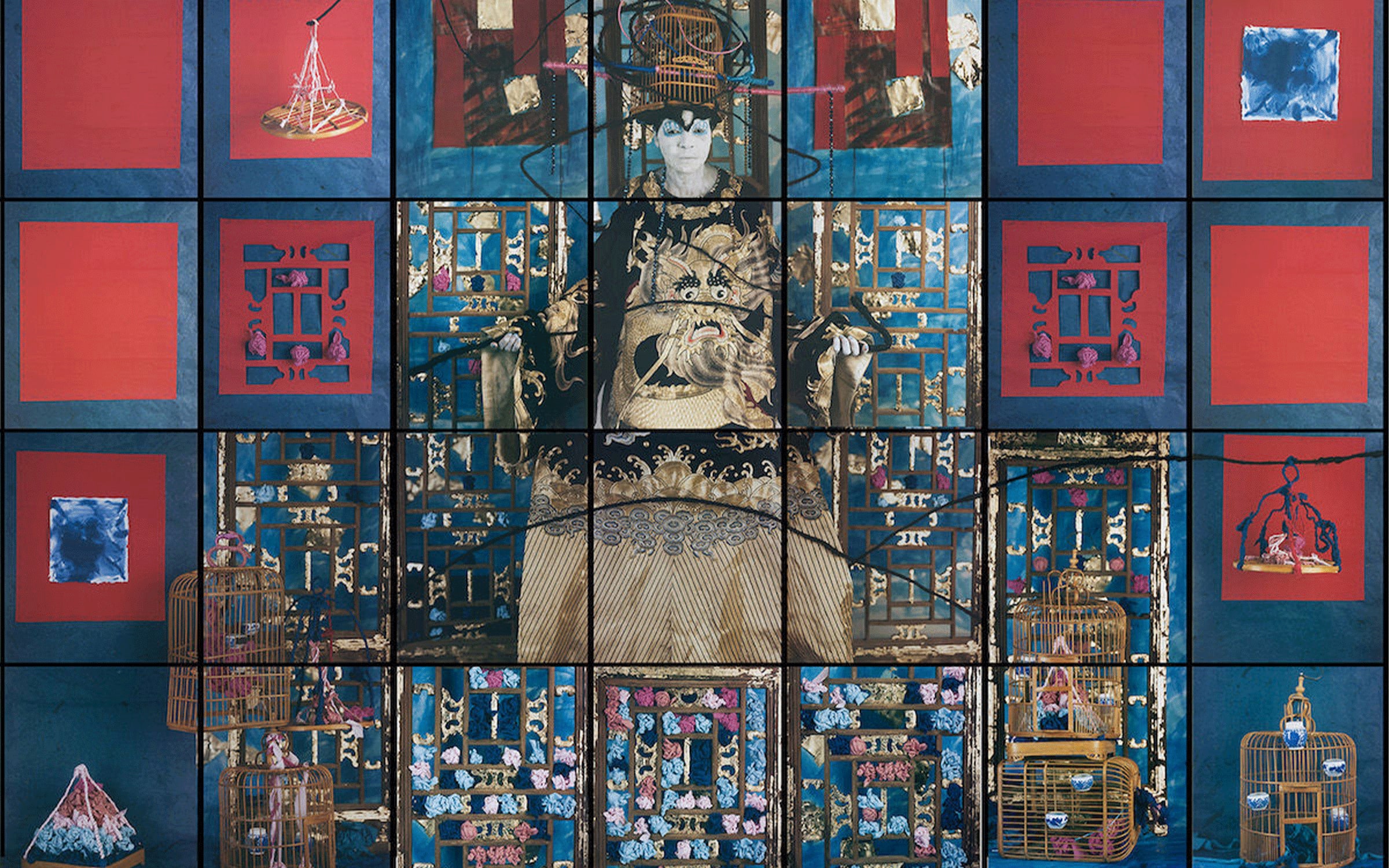

Sugar, the Unbearable Sweetness from the Caribbean Sea
Hindley Wang | LEAP October 19, 2022
Andrea Chung’s Bain de Mer (2013), conceived and shown at Helmuth Projects, San Diego that same year comprises a video of the same name and an installation of miniature boats molded in sugar, lodged on a shallow basin of sea water, titled Bato Disik (2013). The site-specific installation sprung from Chung’s Fulbright research in Mauritius in 2009, where she studied food and migration to the island.
“The first time I showed those boats it was incredibly hot here in San Diego and they melted away in a matter of hours,” the Chinese-Caribbean artist recounted in an interview. “I was sort of horrified when I came into the gallery space to see the work.”
In San Diego, the brown, molasse-colored boats were originally lodged in a thin, clear layer of ocean water. The boats’ thick sugar walls were intended to shield against erosion—from time, weather and water. But before long, the liquid surrounding the boats began to warm up to their curves and edges, quietly infiltrating the pores of the solid vessels with heat and moisture. Steamed by the hot air around, the boats begin discharging the pigments, slowly giving away to the open embrace of the transparent body waiting in patience and thirsty for color. Sugar melts into the water. The water devours the sugar. What is becomes once was.
The belly of the boats overturned, and took on the shape of tongues—their appetite exposed, ingesting all the liquid that touches their papillae, as the water too grew more and more insatiable, since its first taste of sweetness.
After only a few hours, all that was left were suggestive skeletons and a dirty, browning pool of remains. Evaporated labor and illicit affairs. Sullied water and dying boats.
Waves of quiet storytelling enter the scene through the sonic portal of the video next to the basin, washing our palette with an aftertaste from the ocean, underneath the summit of Le Morne, a mountain on the coast of Mauritius that was home to a community of escaped slaves during the early 19th century. The narrative unfolds in layers against the sound of the ocean tide racing onto the sandy shore. A disembodied voice quietly begins her sough: “it is said that when the slaves living on the rock saw the soldiers coming, even though it was to tell them of their freedom that they came, they jumped off the rock to their deaths.
It is simply an unbearable story.”

Andrea Chung, Bato Disik, 2013, sugar and water.
The escaped slaves had fled British sugar plantations in the West Indies during the late 18th and early 19th century. They settled into a new life on the summit of the steep cliff of the Le Morne mountain. The perilous cliff was home and shelter for their stolen freedom, until the first day of February in 1835, when emancipation was legitimized. But, for them, that day marked the end of their lives. The ex-slaves spent their last breath resisting the possibility of re-capture and the impossibility of being granted their freedom, by taking a fatal leap, altogether as they had promised one another. Leaping away from a sight of unbearable
contradiction—British soldiers approaching with the news of freedom—the former slaves chose to fulfill their own, final freedom with the affirmation of death.
In the video we see waves gush ashore, quietly percolating the granular sand, leaving only foam, caught in a brief second of stranded embrace between sand and water—as captured time—before retreating altogether, back to the belly of the ocean, gathering for the next push. And so does this unbearable story, told over and over, again and again.
As the waves retreat from the sand, the screen and our ears, the noise of scrubbing enters. In the video, Chung enters the screen with a red bucket to a wall of names written in sugar. The bucket is filled with water from the ocean. Dipping the sponge in the bucket, Chung squeezes the excess water out of the sponge before the erasure, so as to not drown the sugar-coated names. She starts scrubbing the solidified sugar. The texts first appear resilient to the soft sponge, but before long the pigments start to lose their grip and begin to fade.
Chung scrubs harder and harder, as time unfolds and thickens from the fatal leaps of the desperate ex-slaves off the cliff, back to their reclaimed life on the high rock. The voice-over tenuously restarts the narrative of these stolen lives again and again, each time unraveling more life and activities—what they grew and what they ate—each venture of stolen freedom is spilled out little by little, as the scrubbing takes away more and more.
The water thickens. In this sacred oasis, hope swells and dries, right before the plummeting despair announces itself at the end of each retelling, throwing all of it along with themselves down to the shallow water below, again and again.
Chung returns to the beach and walks into the ocean, discharging the remaining sugar-tainted salt water from the red bucket back to where it came—back to where they went.
The boats melted. The sugarcoated names erased. The staged sugar vessels gesture a resistance, to forced separations, intimating journeys unforeseen yet incumbent, where the vessel becomes embroiled and swallowed—nocturnal passages and illicit indentures bearing indigestible outlaws passing down unbearable stories. Mouths of water conjoining, changing tongues and passing bodies. These routes across the Pacific and the Atlantic configure a map of dispossession and home-making, of diaspora and intimacies, undercutting that of Columbus’s like water undermining sugar, diffused but indelib

Andrea Chung, Sink and Swim, 2013.
Sugar, fishing line, fishing hooks, nuts, bolts, revolution, and time.
Site-specific installation at the McColl Center for the Arts
Sugar, fishing line, fishing hooks, nuts, bolts, revolution, and time.
Site-specific installation at the McColl Center for the Arts
In his canonical 1994 essay “Cultural Identity and Diaspora,” the Jamaican-born British postcolonial and cultural theorist, Stuart Hall, ruminates on the emergent positions of enunciation of the postcolonial subject (with their diasporic experiences and traumas) in the new Caribbean cinema of the time. Hall problematizes the concept of a [emphasis mine] Caribbean identity by facing its challenges from the past—of profound discontinuity and rupture, through bodies of transported slaves from Africa and temporary indentured laborers from Asia onto the islands of the Caribbean. In a poignant ellipsis, Hall writes: “(… when you visit Guyana, Trinidad, you see, symbolically inscribed in the faces of their peoples, the paradoxical ‘truth’ of Christopher Columbus’s mistake: you can find ‘Asia’ by sailing west, if you know where to look!)”.
How have mistakes become truths? Columbus’s misidentification and disorientation impregnated a subterranean map, which bloomed two centuries after, dispersing Africa and Asia into the Americas, melting and melding in streams of sweat, blood, and shit.
New sites of exchange and unruly intimacies are mapped on the ex-colonizer’s taste and desires for sugar on the plantations, intersecting African diaspora with Chinese diaspora at the meeting point of the Caribbean by the early 19th century. Following the social unrest and famine that ensued after the first and second Opium War and the Taiping Rebellion, Chinese migration to the Caribbean soon reached its height by the mid-19th century. Their migration was encouraged by a colonial scheme implemented in 1806, and later known the ‘Trinidad experiment’, and as a result of which 200 Chinese were sent to the Caribbean colony at the other end of the Pacific. Chinese indentured laborers were imported to the Caribbean as a “racial barrier”, to ease the aftershock from the slave rebellions in St. Domingo. The Chinese “coolies” were expected to “be kept distinct from the Negros.” “A free race”—so neutral of color that they were almost invisible. The colonial expectation of racial separation in this experiment was soon dispelled, as babies were born from Chinese wombs to black fathers. (Although another rendition of it prevailed in Mauritius, the “great experiment” of Asian indenture in 1834.) Dr. Tao Leigh Goffe contends in her essay “Sugarwork: The Gastropoetics of Afro-Asia After the Plantation,” that artists like Wifredo Lam, Maria Magdalena Campos-Pons are testaments to its failure, its indigestible legacies, the parts of the map unplanned. The stories told by artists of Chinese Cuban/Afro-Asian/Afro-Caribbean diaspora, linger on the sutures of the broken water, crossed frontiers, transgressed bodies, tangled tongues, estranged articulations. Unbearable stories.
Andrea Chung bears her own version of such a story, as a descendant of Jamaican/Chinese and Trinidadian heritage growing up in Houston, Texas. Sink and Swim(2013) picks up the ends of the stories on Mauritius explored in Bain de Mer (2013) of the afterlife of the newly emancipated slaves. During Chung’s Fulbright years spent on the islands in Mauritius, she discovered that the local inhabitants, also known as Mauritian Creoles (the survivors and descendants of continental African slaves) turned away from sugar canes after emancipation and looked out to the sea for a living. They established fishing as a trade and built their villages and life around it. Chung remodels the state of this life in the form of bottles, hung on fishing lines, shattered, immersed, suspended–—quietly melting. The bottles are cast out of sugar and glass, displayed in their various modes in making a living for the islanders while also embodying the various stages of life with their own bodily fractures. Sink and Swim was featured in the exhibition “Circles and Circuits I: History and Art of the Chinese Caribbean Diaspora” at California African American Museum (CAAM), Los Angeles in 2017. Her participation in this groundbreaking exhibition marked a full-circle moment for Chung personally: her work was showcased alongside Cuban-born Maria Magdalena Campos-Pons’s Finding Balance (2015). She recalls her first time seeing this work in an exhibition catalog in graduate school: it “was the first time I saw someone articulate my story visually. My family is also of Afro-Chinese Caribbean heritage.”

Maria Magdalena Campos-Pons, Finding Balance, 2015. 28 Polacolor Polaroids, each unframed panel 67 x 57.8 cm, overall unframed 268 x 404.5 cm. Courtesy the artist.
Finding Balance is a mixed-media work in the form of a 7 x 4 grid, guarded by a daunting central figure, whose face is painted in petrifying white. A ghostly presence. The surrounding panels are grouped into their cautious formations, symmetrically around the figure like a fortified frame. The gaze of the figure pierces down from the top central panel straight at the beholder. A golden dragon coils around her garment, evocative of a Chinese empress. The white pigment on her face works like a masquerade, simultaneously effacing and announcing her ambiguous identity. A bird cage is balanced on her head, and dislodged at the foot of the work, all the while manifesting the visual logic of the cage within the pictorial arrangement of the grid. The bronze dish of the traditional Chinese steelyard scale is set against a red square within a blue frame on the top left corner. The slight misalignments and symmetrical repetitions of the frames enclose the central figure, appearing at once scaffolded and animated, creating slippages out of confinement.
Born in the town La Vega of Matanzas in Cuba, Maria Magdalena Campos-Pons grew up in a former sugar mill plantation. Sugar was ingrained like the lining of Campos-Pons’ memory of her past and future, that of African, Hispanic, Chinese and Caribbean heritages. Sugar was her way of making sense of the world, sugar makes up the senses in her world. In 2010, Campos-pons exhibited a site-specific installation at the Smith College Museum of Art in Northampton Massachusetts, titled Sugar/Bittersweet. It comprises a room full of variously sized disks of sugar in various states or refinement pierced and held in place by sharp spears supported on stools. As if waiting silently in solemn conformity. The spears are African, and the stools African and Chinese. The lick of sugar becomes perilous, guarded by the stylistic spikes. The sugar disks range in tone from white (refined), mulatto (in-between), brown (raw) and the color of molasses. This is not a view of the greenery sugarcanes, but hardened facts of ossification, penetration, and accumulation, staging silent resistance. From the making of sugar to and the marking of difference and indifference, the blades cut through.
“Sugar makes me cry,” says the artist, “and the tears are salty and bitter.”
Campos-Pons’s Sugar/Bittersweet and Chung’s Bato Disik capture a stasis, as if stealing time from the irreversible and inexorable journey that sugar will then embark on and has undertaken. It is, has been and will always be a long journey, not just in water or on water, not just in time or in past time. The artists’ focus on the very substance brings an awareness to the body that history is not usually aware of, through senses that elude and erode “common sense.” Insoluble intimacies. Through the digestive systems of the laboring sweat and blood on the plantations, sugar eventually makes it to the bottom of the tea in English society, to the cavity in the teeth of British Bourgeoisies. “I was coming home. I am the sugar at the bottom of the English cup of tea. I am the sweet tooth, the sugar plantations that rotted generations of English children’s teeth,” exclaims Stuart Hall in “Old and New Identities, Old and New Ethnicities” (1991). Hall articulates an intimate metabolic cycle that crosses oceans—and the karmic circuits of excess desires: indigestible waste, crystallized from exploited labor, making itself at home in the belly of the beast. Holes that cannot be filled, right next to their tongues, their insatiable tastes for sugar.